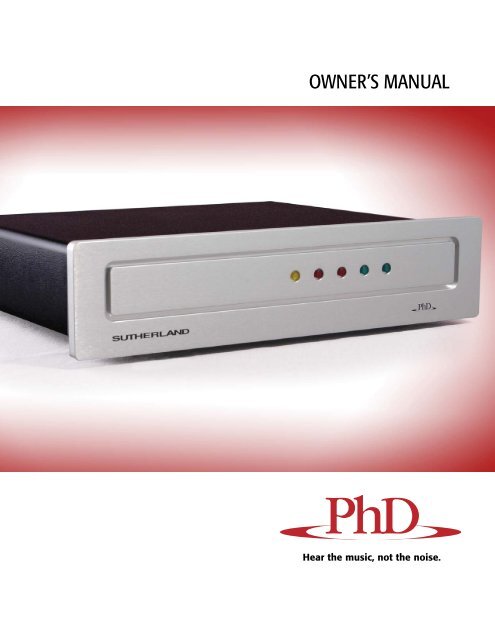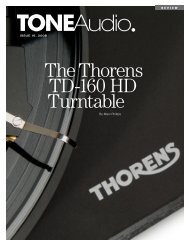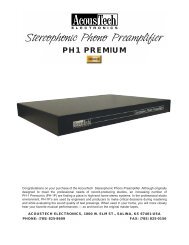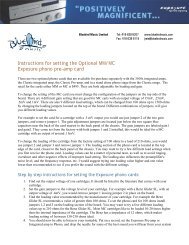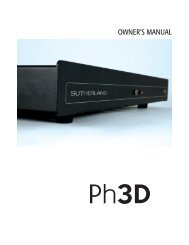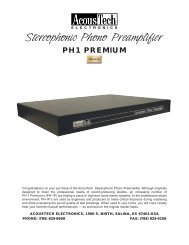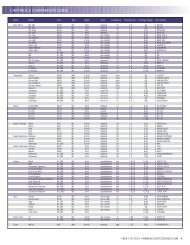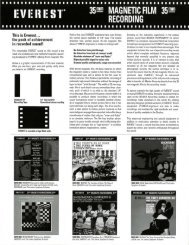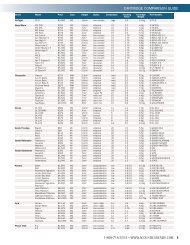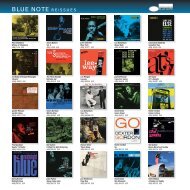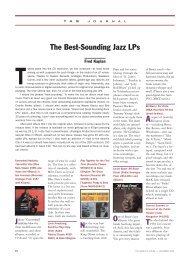Download Ph.D. Owners Manual - Acoustic Sounds
Download Ph.D. Owners Manual - Acoustic Sounds
Download Ph.D. Owners Manual - Acoustic Sounds
You also want an ePaper? Increase the reach of your titles
YUMPU automatically turns print PDFs into web optimized ePapers that Google loves.
OWNER’S MANUAL<br />
Hear the music, not the noise.
YOUR SUTHERLAND <strong>Ph</strong>.D.<br />
Congratulations! You now own the quietest phono<br />
preamp you’ll ever hear. Please take a few minutes<br />
to review the specifications, setting options and<br />
highlights for your easy-to-operate Sutherland <strong>Ph</strong>.D.<br />
Although designer Ron Sutherland had already<br />
achieved Class A performance with the AcousTech<br />
<strong>Ph</strong>-1 phono preamp, he knew there was room to<br />
improve while still keeping the manufacturing cost reasonable.<br />
In designing the <strong>Ph</strong>.D., Sutherland focused on<br />
improving the purity of the power source and on lowering<br />
the background noise floor. Both<br />
goals are interrelated.<br />
An amplifier does not make the input signal “bigger.”<br />
Instead, it uses the input signal to control the delivery<br />
of power from a power supply. So the size of the<br />
output signal comes entirely from the power supply.<br />
The quality and purity of the power supply is an<br />
essential foundation for creating a high-quality output<br />
signal. Still, in many designs, the power supply is given<br />
only casual consideration.<br />
Consider that one of the noisiest components in your<br />
home stereo is the incoming AC power. Even if it were<br />
delivered to your home as idealized 60 Hz sine wave,<br />
it would not stay that way long. One of the biggest<br />
polluters is the audio power amplifier. It does not draw<br />
current from the power line evenly. There is a large<br />
current spike drawn when the sine wave reaches its<br />
voltage extremes, while at other times current draw is<br />
essentially zero. High-frequency harmonics and noise<br />
are introduced into the same power line used for<br />
sensitive phono preamplification. There are, of course,<br />
many other factors that contribute to power line<br />
distortion and noise.<br />
While several preamplifier designs have aimed to<br />
isolate the AC power line with varying degrees of<br />
success, ultimate power supply purity cannot be<br />
achieved without absolute elimination of the AC power<br />
line. In the case of the Sutherland <strong>Ph</strong>.D., there is no<br />
connection to the AC power line at all — period.<br />
Instead, the power for the <strong>Ph</strong>.D. is 16 alkaline D cells.<br />
In this application, the batteries have a useable lifetime<br />
of over 800 listening hours. As they age, low-power<br />
supply impedance is maintained by high-value storage<br />
capacitance. And unlike designs that use rechargeable<br />
batteries, the <strong>Ph</strong>.D. is not compromised and encumbered<br />
with battery-charging circuitry. In fact, one of the<br />
surprising features of the <strong>Ph</strong>.D. is the absence of ANY<br />
power connections on the back panel. It is totally isolated<br />
from any outside power noise.<br />
To bring the sonic advantages of primary battery<br />
power into a practical product required the development<br />
of a sophisticated power management system. If<br />
a conventional power switch were used on the <strong>Ph</strong>.D., it<br />
is almost certain that it would sometimes accidentally<br />
be left in the on position thereby draining the battery<br />
life much faster than necessary. Instead, Sutherland<br />
designed a power manager that monitors for a signal<br />
from the turntable, or specifically the stylus. Once a<br />
signal is detected, such as anytime the stylus is<br />
stimulated by cleaning or contacting a record, the<br />
<strong>Ph</strong>.D. will power-up for 30 minutes at which time signal<br />
monitoring is inhibited to again avoid any impact on<br />
the low-noise environment. From there, the unit<br />
automatically looks for a signal every half-hour<br />
(indicated by a yellow light flicker) for just a fraction of<br />
a second. If it doesn’t find a signal, it will stay on for an<br />
additional half-hour with a yellow light indicating that it<br />
is preparing to turn off.<br />
In designing the <strong>Ph</strong>.D., Sutherland concentrated on<br />
eliminating needless power consumption. So as very<br />
little power is used, very little heat is generated within<br />
the components. There is essentially no temperature<br />
rise and no need for “warm-up” time. The design also<br />
has very little or no dc voltage across the signal-carrying<br />
capacitors, so that dielectric forming is not an<br />
issue. If you do prefer to power-up (notice, we did not<br />
say “warm-up”) the <strong>Ph</strong>.D. before listening, simply tap<br />
the cartridge headshell or brush the stylus. The unit<br />
will power-up, and you'll be set to jam!<br />
Hear the music, not the noise.
INDICATORS<br />
Front panel indicators show the status of the power<br />
management circuit. When a music signal is detected,<br />
both green lights will illuminate, indicating that the unit<br />
is operating properly. Within a fraction of a second,<br />
the <strong>Ph</strong>.D. is powered-up and stable.<br />
CONFIGURATION<br />
Conventional designs use inexpensive, low-quality<br />
computer rocker switches. Their design is inadequate<br />
for configuring the low-level signal from a phono<br />
cartridge. To offer the user a wide range of<br />
configurations while maintaining signal integrity,<br />
the <strong>Ph</strong>.D. incorporates a unique plug-in configuration<br />
circuit board.<br />
Each channel of the <strong>Ph</strong>.D. has two configuration<br />
boards: One to select cartridge loading and a second<br />
to select gain. Each board is square, and each side<br />
of the square has an associated configuration value.<br />
Settings are easily adjusted by unplugging the board<br />
and rotating it to the desired value. This approach<br />
gives the highest-quality connections with the<br />
shortest and most direct signal path. The correct<br />
orientation that the configuration board is set<br />
at is indicated by reading the board when you<br />
are facing the front of the <strong>Ph</strong>.D. unit. It will<br />
be the only number that is readable or<br />
right-side-up.<br />
The Sensitivity Control sets the threshold of the<br />
signal monitor. It is set at the midpoint when shipped.<br />
Since there is quite a variance in the output voltage of<br />
phono cartridges, some adjustment may be necessary.<br />
If the <strong>Ph</strong>.D. sometimes turns itself on when there is<br />
no musical signal, reduce the monitor sensitivity by<br />
turning the control clockwise. If the Yellow light stays<br />
on while music is playing, increase the monitor<br />
sensitivity by turning the control counterclockwise.<br />
NOTE: This control does not affect the audio circuit.<br />
CONSTRUCTION<br />
The <strong>Ph</strong>.D. is built within a 12-gauge steel case for extreme<br />
levels of rigidity and magnetic shielding. To maintain signal<br />
integrity, the <strong>Ph</strong>.D. uses a gold-plated printed circuit board<br />
that provides a lifetime of undiminished performance.<br />
The physical component design uses a dual mono layout<br />
so that each channel sees the same signal path, thus<br />
enabling subtle gain and phase balance between channels.<br />
The <strong>Ph</strong>.D.’s signal path is built upon experience derived<br />
from the Sutherland PH-2000 and the AcousTech PH-1P<br />
(both Stereophile Class A components). Refinements<br />
were made to reduce the noise level in the established<br />
musicality of those designs.<br />
Every 30 minutes, the yellow light will briefly illuminate,<br />
indicating that the unit is checking for a continuing musical<br />
signal. If a signal is detected, power is extended for an<br />
additional 30 minutes.<br />
The red lights indicate that the batteries are running low.<br />
Location of two configuration boards and sensitivity control.<br />
Supplied loading values:<br />
• 100 ohms<br />
• 200 ohms<br />
• 1k ohms<br />
• 47k ohms<br />
sensitivity<br />
control<br />
Supplied gain values:<br />
• 45 dB<br />
• 50 dB<br />
• 55 dB<br />
• 60 dB<br />
If you want loading or gain values that are not included<br />
in these stock values, blank configuration boards and<br />
custom configured boards are available.<br />
The rear panel includes inputs, outputs and a ground<br />
lug, as well as the LED indicator guide and instructions<br />
for removing the <strong>Ph</strong>.D.'s cover.
<strong>Ph</strong>.D. SPECIFICATIONS and OPTIONS<br />
Gain Settings<br />
Cartridge Loading<br />
Noise<br />
THD + noise<br />
Indicators<br />
Size<br />
Weight<br />
Power Requirements<br />
Battery Life<br />
45 dB<br />
50 dB<br />
55 dB<br />
60 dB<br />
100 ohms<br />
200 ohms<br />
1k ohms<br />
47k ohms<br />
Noise: Less than 150 uV<br />
‘A’ weighted<br />
47k ohms<br />
50 dB gain<br />
Less than 400 uV<br />
‘A’ weighted<br />
200 ohms<br />
60 dB<br />
Less than 0.02%, ‘A’ weighted<br />
Green: Power On<br />
Yellow: Signal Monitor<br />
Red: Low Batteries<br />
17" wide<br />
4 " high<br />
14" deep<br />
38 lbs. net (with batteries installed)<br />
41 lbs. shipping<br />
16 Alkaline ‘D’ cells<br />
Greater than 800 hours<br />
Sutherland Engineering products, like those of AcousTech Electronics,<br />
are designed by Ron Sutherland for exclusive distribution through <strong>Acoustic</strong> <strong>Sounds</strong>, Inc.<br />
1000 W. Elm, P.O. Box 1905, Salina, Kansas 67402<br />
785.825.8609 • Fax 785.825.0156 • www.acousticsounds.com<br />
Smart Circuitry


